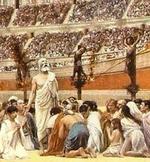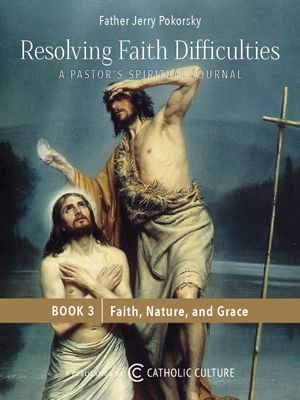Make your gift today!
Help keep Catholics around the world educated and informed.
Already donated? Log in to stop seeing these donation pop-ups.
Reading the Greats during the Year of Faith: Newman and Chesterton
By Dr. Jeff Mirus ( bio - articles - email ) | Nov 20, 2012 | In Reviews
There are all kinds of special reading we could and should be doing during the Year of Faith. The Church recommends the documents of Vatican II and the Catechism and so, as far as study goes, these should be at the top of our list. But neither of these is properly spiritual reading, and that is another important responsibility, one which certainly should not be neglected during the Year of Faith. And neither of these is the kind of Christian literature that can be read for sheer enjoyment. I believe that we ought to be able to find authors in that category, too.
Indeed, it is the last category that interests me today, chiefly because Sophia Institute Press has just published The Quotable Newman, compiled by Catholic apologist Dave Armstrong, who excels at presenting well over a thousand short extracts from Blessed John Henry Newman’s extensive works. These are organized in a kind of encyclopedia of topics, ranging from Absolution, Adam and Angels (the first three topics) to Transubstantiation, Trent (Council of), and Trinitarianism (the last three). In between we have over a hundred other topics, including Conscience, Faith and Reason, Jesus, Mary, Penance, Relics, Sanctification, and Sin.
The subtitle is “A Definitive Guide to His Central Thoughts and Ideas”. I don’t think the subtitle particularly apt, since there is no real guidance as to what is central, and the proposition that over 100 different topics were all “central” is obviously dubious. But there is no question that common themes and important emphases emerge as one reads. And when dealing with a deep and far-reaching intellect such as Newman’s, it is an incomparable blessing to be able to find a favorite passage again because you remember that it was under the heading of “Eden” in this collection.
Another very positive aspect of this division into topics is that it enables Armstrong to present a chronological series of Newman’s comments on each topic, which shows the development of his thought over time. Often our understanding of a later item is illuminated by an earlier one, or vice versa. This is particularly valuable in that Armstrong includes extracts from Newman’s Anglican period only when one can follow the growth of his ideas through follow-up comments after he converted to Catholicism. Extracts range from a few lines to about a page and a half each.
Now you might think that this would all be hard work, but for serious readers who deeply appreciate not only the depth of Newman’s insight but the astonishing balance, beauty and precision of his prose, reading almost anything by Newman is a great joy—a special kind of participation in the perceptive luminosity of one of the leading intellects of the 19th century, except that Newman was so far ahead of his time that nearly all of his insights seem strikingly apt even today. Indeed, Newman had a formidable mind, but it was a mind which subordinated itself to Christ and to the Church and to charity, and so led him and many others on to sanctity.
Sophia Institute Press was recently acquired by Thomas More College of the Liberal Arts (New Hampshire) and Holy Spirit College (Georgia), fine sister institutions that are now using the Press as their joint publishing division. This volume was an excellent early choice for their new operation. However, if you would prefer to combine two phases of your reading into one, I can also recommend another Newman collection, published by Scepter in 2003, which consists not of snippets but of longer extracts solely on the spiritual life, and therefore is eminently suitable for spiritual reading: The Rule of Our Warfare: John Henry Newman and the true Christian Life, edited by John Hulsman.
When I conceived the idea of reviewing The Quotable Newman I decided to pair it with something by at least one other English Catholic author, and I thought I had just the thing in the announcement of Dale Ahlquist’s The Complete Thinker: The Marvelous Mind of G. K. Chesterton, newly published by Ignatius Press. I requested the book believing it to be an anthology, but it turns out to be an appreciation, which I will take up in due course. For the present purpose, I asked Ignatius if they had not recently published a Chesterton collection that I could use, and in fact they had done so last year: In Defense of Sanity: The Best Essays of G. K. Chesterton. The essays are selected from among hundreds by Dale Ahlquist, Joseph Pearce and Aidan Mackey.
Like Newman, Chesterton was multi-talented as a writer: theology, philosophy, history, and literature in the form of essays, novels, and poetry. Newman, of course, also wrote and delivered sermons, but then Chesterton has stories, including detective stories, many of which feature the plain, ordinary and utterly deceiving Father Brown. But where Newman’s great strength as a thinker and writer was his clear, comprehensive and systematic exposition of each idea, Chesterton illuminated nearly always by using his imagination to throw his subject into a clear but unexpected burst of light. He almost always turned things upside down, the better to appreciate what they really looked like. He delighted in paradox.
A joyful sense of the unexpected made almost everything Chesterton wrote a delight. he carries us along almost effortlessly to a fairyland, and then we find ourselves startled to recognize, in the end, that this is actually the world we live in, a world too often underappreciated when seen through the eyes of an all too conventional boredom. Chesterton could open up vistas of history and theology by examining what he found in his pocket during a long ride on a train—and he did. Chesterton could illuminate the difference between the sexes by considering the wisdom of communal kitchens, or scoff at human pride while running after his hat, or demonstrate that what appears to be the new freedom of fashionable thought is really a new prudery, or that what passes for reason is really the rout of reason.
Chesterton has been called the master without a masterpiece because he wrote so well in every genre, but some readers grow impatient with him because he seems to go off on tangents instead of proceeding directly to the point. As a general rule, however, it is the tangents that illuminate the point, taking us on a sort of tour which puts everything in a new light, and which turns out in the end to have been a tour de force. There are sixty-seven essays which fit this description within the covers of In Defense of Sanity.
If you revel in finally understanding what you expect to read about, you’ll prefer Newman. But if your joy comes in apprehending the expected as a gift that is almost deliriously unexpected, then it will be Chesterton for you every time. Of course, you can love them both, as great friends for different days and different moods and different needs. That’s what I have done—and have again set out to do—in this Year of Faith.
All comments are moderated. To lighten our editing burden, only current donors are allowed to Sound Off. If you are a current donor, log in to see the comment form; otherwise please support our work, and Sound Off!








